
The river Ticino is the most important perennial left-bank tributary of the Po. It has given its name to the Swiss canton through which its upper portion flows.

Stresa is a town and comune of about 4,600 residents on the shores of Lake Maggiore in the province of Verbano-Cusio-Ossola in the Piedmont region of northern Italy, about 90 kilometres (56 mi) northwest of Milan. It is situated on road and rail routes to the Simplon Pass.

Lake Maggiore or Verbano is a large lake located on the south side of the Alps. It is the second largest lake in Italy and the largest in southern Switzerland. The lake and its shoreline are divided between the Italian regions of Piedmont and Lombardy and the Swiss canton of Ticino. Located halfway between Lake Orta and Lake Lugano, Lake Maggiore extends for about 64 kilometres between Locarno and Arona.

The Borromean Islands are a group of three small islands and two islets in the Italian part of Lago Maggiore, located in the western arm of the lake, between Verbania to the north and Stresa to the south. Together totalling just 50 acres in area, they are a major local tourist attraction for their picturesque setting.
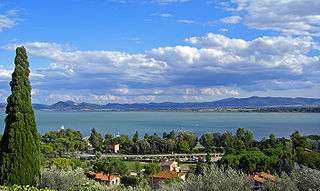
Lake Trasimeno, also referred to as Trasimene or Thrasimene in English, is a lake in the province of Perugia, in the Umbria region of Italy on the border with Tuscany. The lake is south of the river Po and north of the nearby river Tiber and has a surface area of 128 km2 (49.4 sq mi), making it the fourth largest in Italy, slightly smaller than Lake Como. Only two minor streams flow directly into the Lake and none flows out. The water level of the lake fluctuates significantly according to rainfall levels and the seasonal demands from the towns, villages and farms near the shore.
The Piedmont has played an important role in the development of music, in general, in Italy, due to the presence of medieval monasteries in that area, institutions that were great preservers of manuscripts in the Middle Ages as well as being geographically well located to connect to musical influences from northern Europe. As well, the political dominance of the Royal House of Savoy leading up to its eventual installation as the ruling dynasty of united Italy was important.
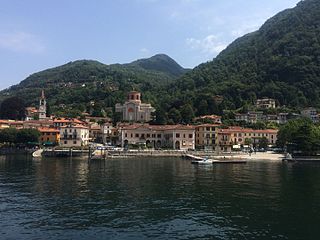
Laveno-Mombello is a comune (municipality) in the Province of Varese in the Italian region Lombardy, located about 75 kilometres (47 mi) northwest of Milan and about 25 kilometres (16 mi) northwest of Varese. As of 31 December 2004, it had a population of 8,991 and an area of 25.9 square kilometres (10.0 sq mi). It sits at the foot of Sasso del Ferro.

The aristocratic House of Borromeo were merchants in San Miniato around 1300 and became bankers in Milan after 1370. Vitaliano de' Vitaliani, who acquired the name of Borromeo from his uncle Giovanni, became the count of Arona in 1445. His descendants played important roles in the politics of the Duchy of Milan and as cardinals in the Catholic Reformation. In 1916, the head of the family was granted the title Prince of Angera by the King of Italy.

Isola Bella is one of the Borromean Islands of Lago Maggiore in Northern Italy. The island is situated in the Borromean Gulf 400 metres from the lakeside town of Stresa. Isola Bella is 320 metres long by 400 metres wide and is divided between the Palace, its Italianate garden, and a small fishing village.
Isolabella or Isola Bella may refer to:
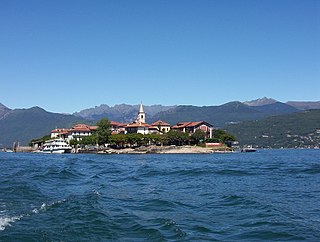
Isola dei Pescatori is an island in Lake Maggiore in northern Italy. As the most northerly of the three principal Borromean Islands it is also known as Isola Superiore and, with a population of 25 in 2018, it is the only one to be inhabited all year round. Unlike Isola Bella and Isola Madre, the island has never belonged to the Borromeo family.

Isola Madre, at 220 m wide and 330 m long, is the largest island of the Isole Borromee archipelago which falls within the Italian part of the Alpine Lake Maggiore, in the Province of Verbano Cusio Ossola, Piedmont. The island is occupied by a number of buildings and architectural structures and is especially well known for its gardens. In the past it was known as Isola di San Vittore and later as Isola Maggiore.

The Brissago Islands are a group of two islands located in the Swiss part of Lake Maggiore close to Ronco sopra Ascona and Brissago. Both islands belong to the district of Locarno, in the canton of Ticino.
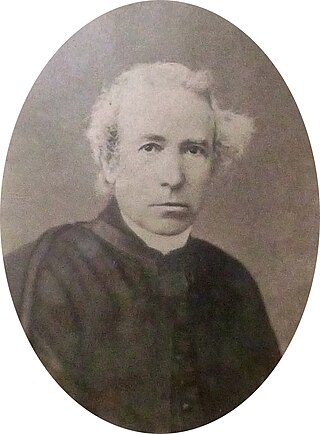
Vincenzo de Vit was an Italian Latin scholar and historian of Ancient Rome.

The Giardini Botanici dell'Isola Madre are historic botanical gardens located on the grounds of Isola Madre in the Borromean Islands of Lake Maggiore, accessible by ferry from Stresa, Province of Verbano-Cusio-Ossola, Piedmont, Italy. They are open daily in the warmer months; an admission fee is charged.

Isola Minore, known until the twentieth century simply as l'isoletta, is the smallest of the three islands of Lago Trasimeno in central Italy, and the closest to Passignano sul Trasimeno within whose municipal boundaries it lies. It rises to about 20 metres above the level of the lake, and takes the form of a comma with dimensions of about 450 x 260 m and an area of some 5 hectares. It is about 470 m NE of the larger island of Isola Maggiore. Isola Minore is covered by woodland, with pines and holm oaks providing protection for the nesting sites of numerous cormorants.
Carlo Iotti or Carlo Jotti was an Italian painter, mainly of landscapes.

The Stresa-Alpino-Mottarone Cable Car is an aerial tramway cable transport located in the commune of Stresa in the Piedmont region of Italy. First opened in 1970, the aerial tramway connects Stresa, located on the shores of Lake Maggiore, to the summit of the Mottarone mountain. The Stresa-Alpino-Mottarone Cable Car transported approximately 100,000 passengers per year, prior to the COVID-19 pandemic in Italy. The aerial tramway was a major regional tourist attraction until the Stresa-Mottarone cable car disaster on 23 May 2021.
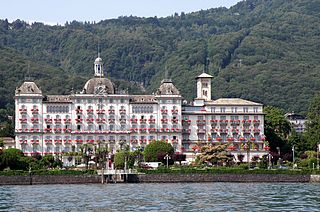
Grand Hotel des Iles Borromées is a historic luxury hotel located on the shores of Lake Maggiore in Italy.


















